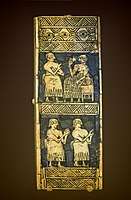Akalamdug
Akalamdug (𒀀𒌦𒄭, A-KALAM-DUG)[2] was an early ruler of the First Dynasty of Ur in the 26th century BCE. He does not appear in the Sumerian King List, but is known from his tomb (Tomb 1332)[3] and an inscription at the Royal Cemetery at Ur.[4][5] He may have been the father of Meskalamdug, as suggested by the similarity of their names and the chronological proximity of their graves.[6] Alternatively, he may have been the son of Meskalamdug, and therefore brother of the great ruler Mesannepada.[7]
| Akalamdug 𒀀𒌦𒄭 | |
|---|---|
| King of Ur | |
.jpg) Seated King on a shell plaque from a lyre, found in tomb PG 1332, Royal Cemetery at Ur. Tomb PG 1332 is thought to belong to King Akalamdug.[1] | |
| Reign | fl. circa 2600 BCE |
| Predecessor | Meskalamdug |
| Successor | Mesannepada |
| House | First Dynasty of Ur |
Artefacts
Several artefacts are known from tomb 1332 at the Royal Cemetery at Ur, such as bull heads and decorated shell plaques from a lyre.[8]
 Inscription related to Akalamdug at the Royal Cemetery at Ur: ".. Ur King Akalamdug"[9]
Inscription related to Akalamdug at the Royal Cemetery at Ur: ".. Ur King Akalamdug"[9] Shell plaque from a lyre, found in tomb PG 1332, Ur Royal Cemetery
Shell plaque from a lyre, found in tomb PG 1332, Ur Royal Cemetery
gollark: <@175686996461617162> Idea: an external EEPROM reader/flasher block.
gollark: Loads to add to libhydraz here.
gollark: REMOVEINSTANTGRAM
gollark: > WinBtrfs v1.4WinBtrfs is a Windows driver for the next-generation Linux filesystem Btrfs. A reimplementation from scratch, it contains no code from the Linux kernel, and should work on any version from Windows Vista onwards. It is also included as part of the free operating system ReactOS.
gollark: Just switch to ReFS!
References
- Art of the First Cities: The Third Millennium B.C. from the Mediterranean to the Indus. Metropolitan Museum of Art. 2003. p. 96. ISBN 978-1-58839-043-1.
- Hall, H. R. (Harry Reginald); Woolley, Leonard; Legrain, Leon (1934). Ur excavations. Trustees of the Two Museums by the aid of a grant from the Carnegie Corporation of New York. p. Plates 163, 191.
- Art of the First Cities: The Third Millennium B.C. from the Mediterranean to the Indus. Metropolitan Museum of Art. 2003. p. 96. ISBN 978-1-58839-043-1.
- Kramer, Samuel Noah (1971). The Sumerians: Their History, Culture, and Character. University of Chicago Press. p. 50. ISBN 978-0-226-45238-8.
- Schmandt-Besserat, Denise (2009). When Writing Met Art: From Symbol to Story. University of Texas Press. p. 68. ISBN 978-0-292-77487-2.
- Hall, H. R. (Harry Reginald); Woolley, Leonard; Legrain, Leon (1900). Ur excavations. Trustees of the Two Museums by the aid of a grant from the Carnegie Corporation of New York. p. 316.
- Reade, Julian (2003). Art of the First Cities: The Third Millennium B.C. from the Mediterranean to the Indus. Metropolitan Museum of Art. p. 96. ISBN 978-1-58839-043-1.
- Hall, H. R. (Harry Reginald); Woolley, Leonard; Legrain, Leon (1934). Ur excavations. Trustees of the Two Museums by the aid of a grant from the Carnegie Corporation of New York. p. Plaques 116, 117.
- Hall, H. R. (Harry Reginald); Woolley, Leonard; Legrain, Leon (1900). Ur excavations. Trustees of the Two Museums by the aid of a grant from the Carnegie Corporation of New York. p. 316.
Sources
- Jane McIntosh: Ancient Mesopotamia. ABC-CLIO 2005, ISBN 1-57607-965-1, p. 73 (restricted online version (google books))
- Leonard Woolley: The Sumerians. p. 38 (restricted online version (google books))
External links
| Regnal titles | ||
|---|---|---|
| Preceded by Meskalamdug |
King of Ur ca. 26th century BC |
Succeeded by Mesannepada |
This article is issued from Wikipedia. The text is licensed under Creative Commons - Attribution - Sharealike. Additional terms may apply for the media files.
